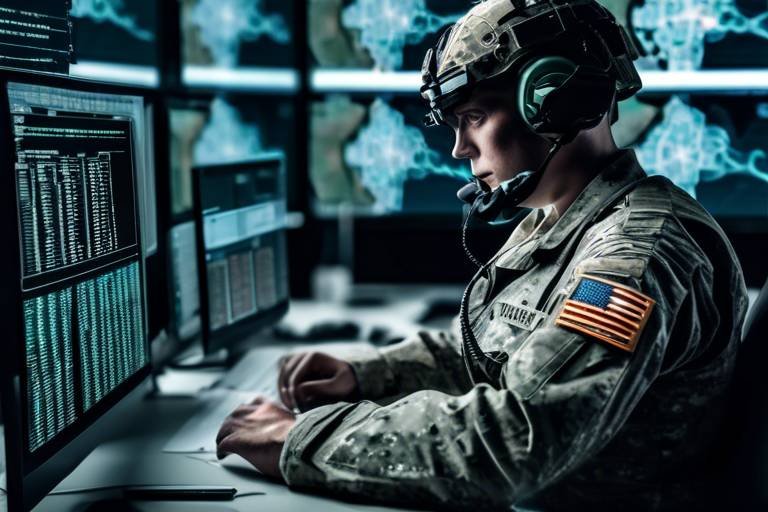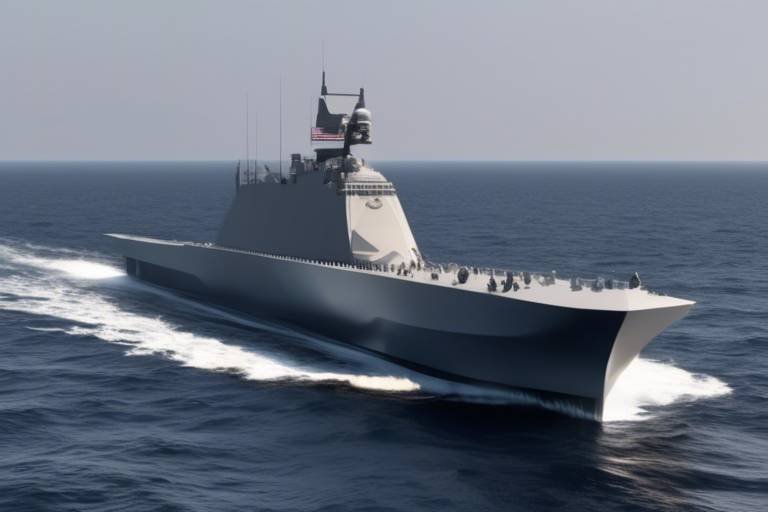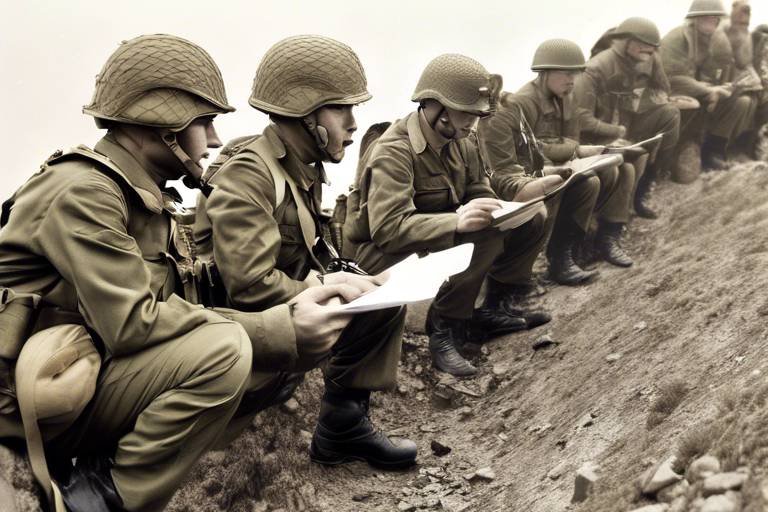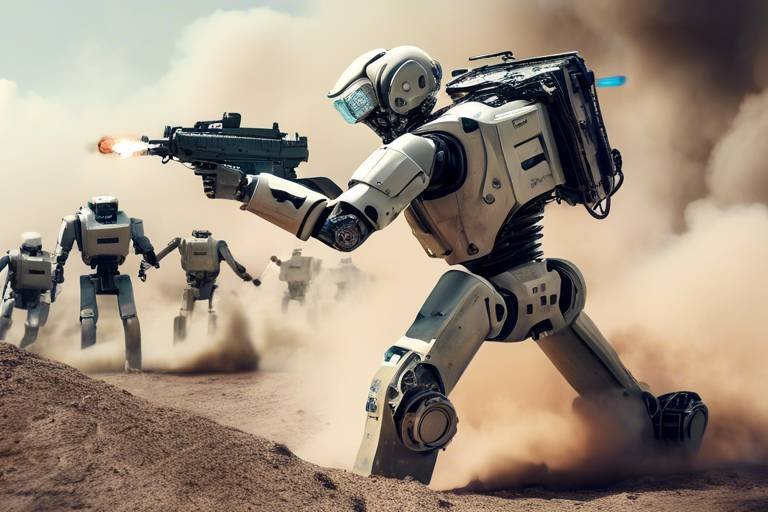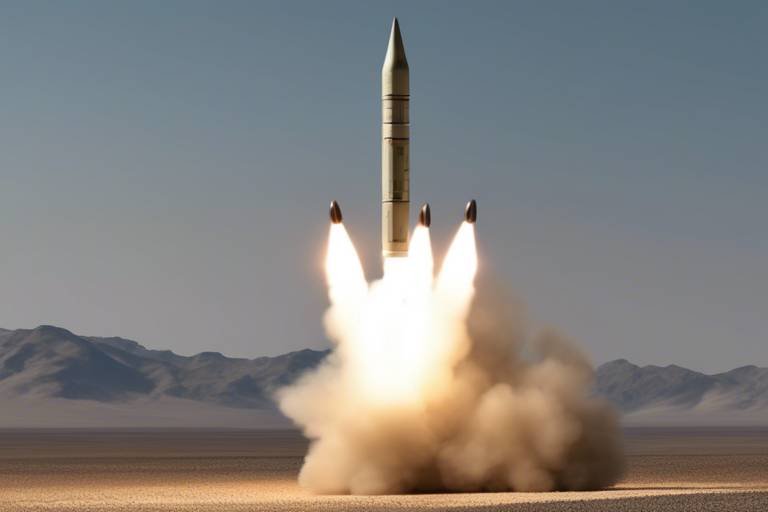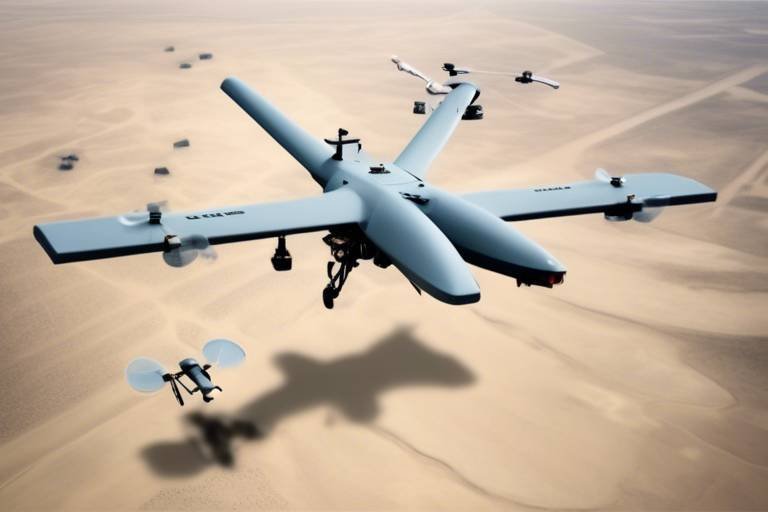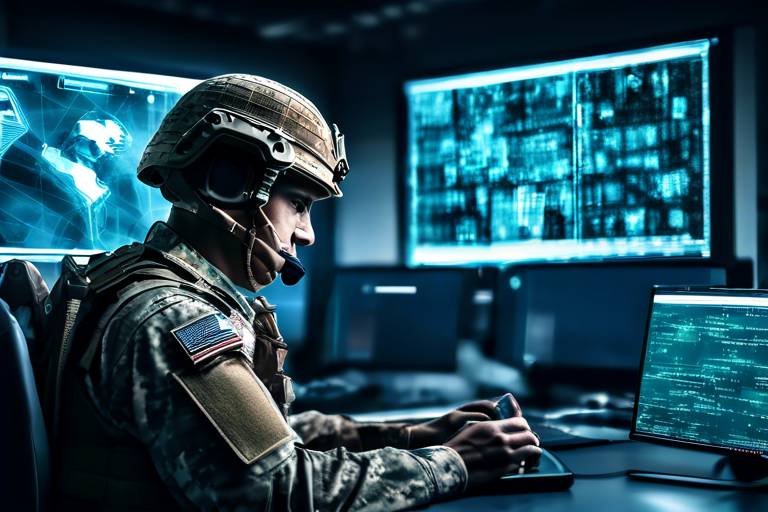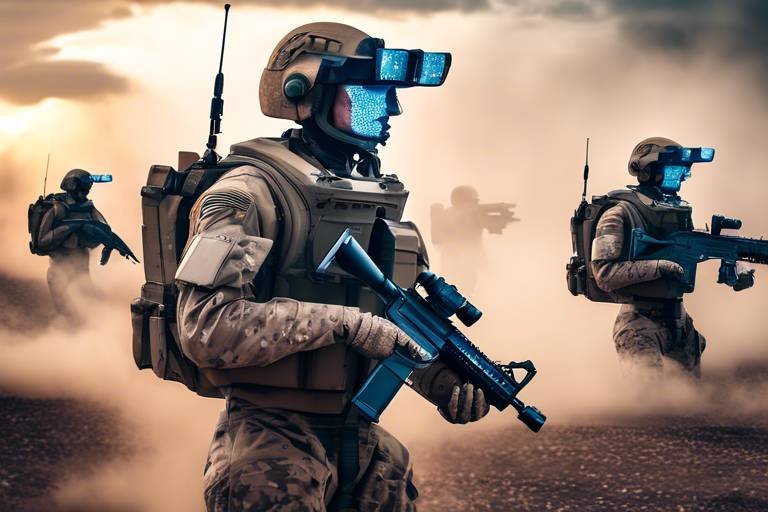The Importance of Collaborative Technologies in Military Planning
In today’s fast-paced and ever-evolving military landscape, the significance of collaborative technologies cannot be overstated. These tools are not just fancy gadgets; they are the backbone of modern military planning, enabling forces to communicate effectively and operate as a cohesive unit. Imagine a well-oiled machine where every cog is perfectly in sync—that’s what collaborative technologies aim to achieve within military operations. By facilitating seamless communication and fostering teamwork, these technologies enhance the ability of military personnel to respond swiftly and decisively to challenges.
As we dive deeper into this topic, we’ll explore how these technologies improve communication, enable real-time data sharing, and strengthen teamwork among military personnel. We’ll also address the interoperability challenges that can arise when integrating various systems and discuss innovative solutions to overcome these hurdles. Ultimately, the goal is to illustrate how collaborative technologies lead to more effective operations and strategic success in military planning.
Effective communication is crucial in military planning. Collaborative technologies streamline information sharing, ensuring that all personnel are on the same page, which is essential for mission success. Picture a battlefield where every soldier is equipped with real-time updates about enemy movements and tactical changes. This level of awareness can make the difference between victory and defeat. By utilizing tools such as secure messaging apps, shared digital platforms, and instant video calls, military teams can communicate without delay, fostering a culture of transparency and responsiveness.
Access to real-time data allows military planners to make informed decisions quickly. Collaborative technologies facilitate the instant sharing of critical information, enhancing situational awareness during operations. Imagine a scenario where a unit on the ground encounters unexpected resistance. With collaborative tools, they can instantly relay this information to command centers, which can then adjust strategies on the fly. This capability not only saves time but also minimizes the risk of miscommunication, ensuring that everyone involved has the most current information at their fingertips.
Integrating various communication systems through collaborative technologies ensures seamless interaction among different military branches, improving coordination and operational efficiency. Think of it as a symphony where each instrument plays in harmony; when all branches of the military work together fluidly, the overall effectiveness of operations is significantly enhanced. However, achieving this level of integration is not without its challenges.
Despite the advantages, interoperability challenges can arise when integrating diverse systems. Different branches may use varied technologies, leading to potential communication breakdowns. Addressing these issues is vital for maximizing the benefits of collaborative technologies. For instance, if one branch is using a particular software that another branch cannot access, it creates a gap in communication that could be detrimental during operations.
Innovative solutions, such as standardized protocols and comprehensive training programs, can help overcome interoperability challenges, ensuring effective collaboration across military units. By establishing common frameworks and conducting regular joint training exercises, military personnel can become proficient in using various systems, thereby enhancing their ability to work together. This proactive approach not only resolves technical issues but also fosters a sense of unity among different branches.
Collaborative technologies enhance decision-making processes by providing access to diverse perspectives and expertise, allowing military leaders to evaluate options more effectively. When individuals from different backgrounds and specialties come together, they bring unique insights that can lead to more robust strategies. This collaborative environment encourages open dialogue and brainstorming, ultimately resulting in well-informed decisions that take into account various factors and potential outcomes.
Teamwork is essential in military operations. Collaborative technologies foster a culture of cooperation, enabling personnel to work together more efficiently towards common goals. When teams feel connected and supported, they are more likely to succeed in high-pressure situations. The ability to collaborate virtually means that even when personnel are stationed in different locations, they can still engage in meaningful discussions and strategize effectively.
Virtual collaboration tools, such as video conferencing and shared platforms, allow military teams to collaborate seamlessly, regardless of geographical barriers, enhancing overall mission readiness. These tools bridge the gap between different units, ensuring that everyone is aligned and aware of their roles and responsibilities. In essence, they create a virtual battleground where ideas can be exchanged freely, leading to innovative solutions and strategies.
Trust is critical for effective teamwork. Collaborative technologies can help build trust among different military units by promoting transparency and open communication, essential for cohesive operations. When military personnel feel confident that their counterparts are informed and engaged, they are more likely to collaborate effectively. This trust translates into better coordination, quicker responses, and ultimately, greater success in achieving mission objectives.
- How do collaborative technologies improve military planning?
Collaborative technologies enhance communication, enable real-time data sharing, and strengthen teamwork, all of which are vital for effective military planning. - What are some common interoperability challenges?
Challenges can include different branches using varied technologies that may not communicate effectively with one another, leading to potential miscommunication. - What solutions exist for overcoming these challenges?
Standardized protocols and comprehensive training programs can help ensure that all personnel are proficient in using various systems, enhancing collaboration. - Why is trust important in military operations?
Trust fosters effective teamwork, leading to better coordination, quicker responses, and greater success in achieving mission objectives.

Enhancing Communication
This article explores how collaborative technologies enhance military planning, improve communication, and foster teamwork among military personnel, ultimately leading to more effective operations and strategic success.
Effective communication is crucial in military planning. Imagine a scenario where a unit is deployed in a high-stakes environment; the success of their mission hinges on every member being informed and synchronized. Collaborative technologies streamline information sharing, ensuring that all personnel are on the same page, which is essential for mission success. By leveraging digital platforms, military planners can disseminate critical information rapidly, allowing teams to react swiftly to changing situations. Whether it’s through instant messaging, video calls, or shared documents, these technologies break down barriers that traditionally hinder communication.
Furthermore, the integration of various communication tools into a cohesive system promotes a culture of transparency. When personnel have access to the same data and updates, it fosters a sense of unity and shared purpose. For example, during a joint operation, real-time updates can be communicated through a centralized platform, allowing all units to adjust their strategies accordingly. This not only improves operational efficiency but also enhances morale, as everyone feels involved and informed.
To illustrate the benefits of enhanced communication, consider the following table that highlights key collaborative technologies and their impact on military operations:
| Technology | Impact on Communication |
|---|---|
| Video Conferencing | Enables face-to-face discussions regardless of location, fostering stronger connections. |
| Instant Messaging Apps | Facilitates quick exchanges of information, reducing response times during operations. |
| Shared Document Platforms | Allows teams to collaborate on plans and reports in real-time, ensuring everyone is updated. |
| Secure Communication Channels | Ensures that sensitive information is shared safely, maintaining operational security. |
In addition, the use of collaborative technologies aids in bridging the gap between different military branches. With diverse units often working together, having a common platform for communication ensures that everyone understands their roles and responsibilities. This integration not only enhances operational effectiveness but also cultivates a sense of camaraderie among service members.
However, it’s important to remember that technology is just a tool. The human element remains vital; fostering a culture that encourages open dialogue and feedback is essential. Training personnel to utilize these technologies effectively can further enhance communication, ensuring that everyone is equipped to share information confidently and accurately.
- How do collaborative technologies improve military communication? They streamline information sharing, ensuring that all personnel are informed and can react quickly to changing situations.
- What are some examples of collaborative technologies used in the military? Examples include video conferencing tools, instant messaging applications, and shared document platforms.
- Why is transparency important in military operations? Transparency fosters trust and unity among personnel, which is crucial for effective teamwork and mission success.
- Can technology replace human communication in the military? No, while technology enhances communication, the human element is vital for building relationships and trust.

Real-time Data Sharing
In the fast-paced world of military operations, is not just an advantage; it's a necessity. Imagine being on the battlefield where every second counts. Decisions made in the heat of the moment can mean the difference between success and failure. Collaborative technologies empower military planners and personnel to access and disseminate crucial information instantaneously, enhancing their situational awareness and responsiveness.
Consider a scenario where a unit is engaged in combat and requires immediate intelligence about enemy movements. With traditional communication methods, there could be delays—messages lost in transit or misunderstood due to poor clarity. However, with real-time data sharing, information flows seamlessly between units. This instantaneous exchange allows for quick adjustments to strategies, ensuring that all team members are aligned with the latest updates.
Furthermore, the integration of advanced technologies such as satellite communications, drones, and mobile applications enables military leaders to visualize the battlefield in real-time. This capability not only enhances decision-making but also allows for a more comprehensive understanding of the operational environment. For instance:
| Technology | Application in Military |
|---|---|
| Satellite Communication | Provides real-time updates from various units, ensuring that all personnel have the latest information. |
| Drones | Offer aerial surveillance, feeding live video feeds to command centers for immediate analysis. |
| Mobile Applications | Facilitate communication and data sharing among troops on the ground, regardless of their location. |
Additionally, the use of secure cloud-based platforms allows for the storage and retrieval of data at lightning speed. This means that military personnel can access historical data, analyze it, and apply those insights to current operations. The ability to pull from past experiences while reacting to present situations creates a powerful synergy that enhances operational effectiveness.
Moreover, real-time data sharing fosters a culture of transparency and accountability within military ranks. When everyone has access to the same information, it reduces the chances of miscommunication and ensures that all team members are working towards the same objectives. This collective understanding is vital for maintaining unity and morale, especially in high-stakes situations.
In summary, the significance of real-time data sharing in military planning cannot be overstated. It not only improves decision-making processes but also enhances coordination among units, ultimately leading to more effective operations. As technology continues to evolve, the military must embrace these collaborative tools to stay ahead in an increasingly complex operational landscape.
- What is real-time data sharing in the military? Real-time data sharing refers to the instant exchange of information among military personnel, enhancing situational awareness and decision-making.
- How does real-time data sharing improve military operations? It enables quick adjustments to strategies based on the latest intelligence, ensuring all team members are aligned and informed.
- What technologies support real-time data sharing? Technologies such as satellite communication, drones, and mobile applications facilitate the rapid dissemination of information.
- Why is transparency important in military operations? Transparency fosters trust and accountability among team members, reducing miscommunication and enhancing teamwork.

Integration of Systems
In today's fast-paced military environment, the is not just a luxury; it’s a necessity. Imagine a well-oiled machine where every cog and wheel works in harmony, each part knowing its role and functioning flawlessly with the others. This is the vision that collaborative technologies strive to achieve in military planning. By integrating various communication systems, military branches can enhance their coordination and operational efficiency. The ability to share information seamlessly across different platforms means that personnel can focus on what truly matters: executing their missions with precision and speed.
When we talk about integration, we’re referring to the interconnectedness of various technologies and systems that allow for smooth communication and data exchange. For instance, consider how different branches of the military—such as the Army, Navy, and Air Force—often operate using distinct systems. Without proper integration, these systems can become silos of information, leading to miscommunication and delays. The goal is to create an environment where information flows freely, enabling all units to act on the same intelligence and make decisions that are informed and timely.
To illustrate the importance of this integration, let’s look at a few key benefits:
- Enhanced Coordination: By integrating systems, military units can coordinate their efforts more effectively, ensuring that everyone is working towards the same objectives.
- Improved Operational Efficiency: Streamlined communication reduces the time needed to relay information, allowing for quicker decision-making and action.
- Increased Situational Awareness: With real-time data sharing, personnel can stay updated on developments across the battlefield, leading to better-informed strategies.
However, achieving this level of integration is not without its challenges. Different branches may use various technologies that are not inherently compatible, leading to potential interoperability issues. These challenges can hinder the flow of information and create gaps in communication that could be detrimental during critical operations. Therefore, addressing interoperability challenges is essential for maximizing the benefits of collaborative technologies.
To overcome these hurdles, innovative solutions must be implemented. Standardized protocols can serve as a common language among different systems, while comprehensive training ensures that personnel are well-versed in utilizing these integrated tools. By investing in both technology and human resources, military organizations can create a robust framework for collaboration that transcends traditional barriers.
In conclusion, the integration of systems through collaborative technologies is a game-changer for military planning. It not only enhances communication but also fosters a culture of cooperation that is vital for success in complex operations. As military forces continue to adopt and refine these technologies, we can expect to see even greater improvements in how they plan and execute their missions.
- What are collaborative technologies? Collaborative technologies refer to tools and platforms that enable individuals and teams to work together more efficiently, regardless of their physical locations.
- Why is system integration important in the military? System integration is crucial as it enhances communication, improves operational efficiency, and increases situational awareness among military units.
- What challenges exist in integrating military systems? Challenges include interoperability issues, technological compatibility, and the need for standardized protocols across different branches.
- How can interoperability challenges be addressed? Solutions include adopting standardized protocols, providing comprehensive training, and investing in compatible technologies.

Interoperability Challenges
This article explores how collaborative technologies enhance military planning, improve communication, and foster teamwork among military personnel, ultimately leading to more effective operations and strategic success.
Effective communication is crucial in military planning. Collaborative technologies streamline information sharing, ensuring that all personnel are on the same page, which is essential for mission success.
Access to real-time data allows military planners to make informed decisions quickly. Collaborative technologies facilitate the instant sharing of critical information, enhancing situational awareness during operations.
Integrating various communication systems through collaborative technologies ensures seamless interaction among different military branches, improving coordination and operational efficiency.
Despite the clear benefits of collaborative technologies, can pose significant hurdles. Different military branches often utilize a variety of systems and platforms, which can lead to complications when trying to share information effectively. Imagine trying to communicate with someone who speaks a different language; without a common understanding, the message can easily get lost in translation.
Some of the main interoperability challenges include:
- Diverse Systems: Each branch may have its own preferred technologies, leading to compatibility issues.
- Data Formats: Varied data formats can hinder seamless information exchange, requiring additional conversion processes.
- Security Protocols: Different security measures can restrict access to essential data, complicating collaboration.
To tackle these challenges, it is crucial to recognize that addressing interoperability is not just a technical issue; it also involves understanding the operational culture of each military unit. By fostering a mindset that prioritizes collaboration and mutual respect, military personnel can work towards overcoming these barriers. In essence, building a bridge between different systems is not merely about technology—it's about building relationships and trust.
Innovative solutions, such as standardized protocols and training, can help overcome interoperability challenges, ensuring effective collaboration across military units.
Collaborative technologies enhance decision-making processes by providing access to diverse perspectives and expertise, allowing military leaders to evaluate options more effectively.
Teamwork is essential in military operations. Collaborative technologies foster a culture of cooperation, enabling personnel to work together more efficiently towards common goals.
Virtual collaboration tools, such as video conferencing and shared platforms, allow military teams to collaborate seamlessly, regardless of geographical barriers, enhancing overall mission readiness.
Trust is critical for effective teamwork. Collaborative technologies can help build trust among different military units by promoting transparency and open communication, essential for cohesive operations.
Collaborative technologies refer to tools and platforms that facilitate communication and cooperation among military personnel, enhancing operational efficiency and effectiveness.
Interoperability challenges can lead to miscommunication, delays in information sharing, and ultimately hinder mission success, as different branches may struggle to coordinate effectively.
Solutions include implementing standardized protocols, providing training for personnel, and fostering a culture of collaboration among different military units.

Solutions for Integration
When it comes to overcoming the interoperability challenges faced by military planners, the solutions lie not just in technology but also in strategic approaches that emphasize collaboration. One of the most effective ways to tackle these challenges is through the implementation of standardized protocols. By establishing common guidelines and frameworks, military units can ensure that their systems communicate effectively, regardless of the underlying technology. This means that whether a unit is using advanced satellite communication or basic radio systems, they can still share critical information seamlessly.
Moreover, training plays a pivotal role in ensuring that personnel are well-versed in these protocols. Regular training sessions can equip military personnel with the necessary skills to navigate different systems and understand the nuances of collaborative technologies. This not only boosts confidence but also fosters a culture of adaptability, where personnel feel empowered to utilize various tools at their disposal.
Another innovative solution is the use of cloud-based platforms. These platforms can serve as centralized hubs for information sharing, allowing military units to access and contribute to a shared pool of data. By leveraging cloud technology, military planners can enhance their situational awareness and decision-making capabilities. Imagine a scenario where a unit in the field can instantly access real-time intelligence from headquarters, enabling them to adjust their strategies on the fly. This level of integration can be a game-changer in high-stakes situations.
Furthermore, incorporating artificial intelligence (AI) can streamline integration efforts. AI can analyze vast amounts of data from different systems, identifying patterns and providing actionable insights. For instance, an AI-driven tool could help predict potential challenges in joint operations, allowing military leaders to proactively address issues before they escalate. This not only enhances operational efficiency but also fosters a proactive approach to military planning.
Ultimately, the key to successful integration lies in a combination of technology, training, and a commitment to collaboration. By addressing interoperability challenges head-on and implementing these solutions, military units can significantly enhance their operational effectiveness. The result? A more cohesive force that is prepared to tackle the complexities of modern warfare.
- What are collaborative technologies? Collaborative technologies refer to tools and systems that enable communication, information sharing, and teamwork among individuals or groups, particularly in complex environments like the military.
- Why is interoperability important in military planning? Interoperability ensures that different military branches can work together effectively, sharing critical information and coordinating operations, which is vital for mission success.
- How can standardized protocols improve military operations? Standardized protocols create a common framework for communication, allowing different systems to interact seamlessly, thereby enhancing coordination and efficiency.
- What role does training play in the integration of collaborative technologies? Training equips military personnel with the skills and knowledge they need to effectively use collaborative tools and understand interoperability challenges, fostering a culture of adaptability.
- Can artificial intelligence really enhance military planning? Yes, AI can analyze data from various sources, providing insights that help military leaders make informed decisions quickly, thus improving overall operational effectiveness.

Improving Decision-Making
This article explores how collaborative technologies enhance military planning, improve communication, and foster teamwork among military personnel, ultimately leading to more effective operations and strategic success.
Effective communication is crucial in military planning. Collaborative technologies streamline information sharing, ensuring that all personnel are on the same page, which is essential for mission success.
Access to real-time data allows military planners to make informed decisions quickly. Collaborative technologies facilitate the instant sharing of critical information, enhancing situational awareness during operations.
Integrating various communication systems through collaborative technologies ensures seamless interaction among different military branches, improving coordination and operational efficiency.
Despite the advantages, interoperability challenges can arise when integrating diverse systems. Addressing these issues is vital for maximizing the benefits of collaborative technologies.
Innovative solutions, such as standardized protocols and training, can help overcome interoperability challenges, ensuring effective collaboration across military units.
Collaborative technologies play a pivotal role in enhancing the decision-making processes within military operations. By providing access to a wealth of data and diverse perspectives, these technologies empower military leaders to evaluate their options more effectively. Imagine a scenario where a commander is faced with multiple strategic choices; in the past, this might have involved long discussions and potential miscommunications. However, with the advent of collaborative technologies, information flows seamlessly, allowing leaders to analyze data in real-time and consult with experts across various fields.
For instance, consider a military operation that requires input from intelligence, logistics, and ground forces. Collaborative platforms enable these units to share insights and updates instantaneously. This not only accelerates the decision-making process but also ensures that decisions are well-informed and reflective of the current situation on the ground. A recent study indicated that units utilizing collaborative technologies reported a 30% increase in decision-making speed, which can be the difference between success and failure in critical operations.
Moreover, the incorporation of artificial intelligence (AI) within these collaborative frameworks can further enhance decision-making capabilities. AI can analyze vast amounts of data, identify patterns, and even predict outcomes based on historical data. This allows military leaders to make not just quicker decisions but also more strategic ones. The integration of AI tools within collaborative environments is revolutionizing how military decisions are made, ensuring that leaders have the best possible information at their fingertips.
In summary, the enhancement of decision-making through collaborative technologies is not just about speed; it's about creating a more informed and cohesive approach to military operations. The ability to harness collective knowledge and insights leads to more robust strategies and ultimately, greater operational success.
Teamwork is essential in military operations. Collaborative technologies foster a culture of cooperation, enabling personnel to work together more efficiently towards common goals.
Virtual collaboration tools, such as video conferencing and shared platforms, allow military teams to collaborate seamlessly, regardless of geographical barriers, enhancing overall mission readiness.
Trust is critical for effective teamwork. Collaborative technologies can help build trust among different military units by promoting transparency and open communication, essential for cohesive operations.
- How do collaborative technologies improve military operations?
Collaborative technologies enhance communication, streamline data sharing, and facilitate teamwork, leading to more effective military operations. - What are some examples of collaborative technologies used in the military?
Examples include video conferencing tools, shared digital workspaces, and real-time data analytics platforms. - How does real-time data sharing impact decision-making?
Real-time data sharing allows military leaders to make informed decisions quickly, improving situational awareness and operational effectiveness. - What challenges exist with integrating collaborative technologies?
Interoperability challenges can arise when different systems do not communicate effectively, but solutions such as standardized protocols can help mitigate these issues.

Strengthening Teamwork
Teamwork is the backbone of any successful military operation. In an environment where the stakes are incredibly high, the ability to work together effectively can mean the difference between victory and defeat. Collaborative technologies play a pivotal role in by creating an atmosphere where communication flows freely and personnel can easily share their insights and expertise. Imagine trying to assemble a complex puzzle without knowing what the final picture looks like; that’s what military operations can feel like without effective collaboration. By leveraging technology, military teams can visualize the entire operation, ensuring that everyone is aligned and working towards a common goal.
One of the most significant advantages of collaborative technologies is their ability to break down geographical barriers. With tools like video conferencing and shared digital platforms, military personnel stationed in different locations can come together in real time. This is akin to having a virtual command center where ideas, strategies, and plans can be discussed and refined instantly. For instance, a battalion in one country can seamlessly collaborate with a unit across the globe, sharing insights and updates that keep everyone informed and engaged. This level of connectivity not only enhances mission readiness but also fosters a sense of unity and purpose among team members.
Moreover, the use of collaborative technologies cultivates an environment of trust and transparency. When personnel can communicate openly and share information without barriers, it builds confidence among team members. Trust is essential in military operations, where decisions often need to be made swiftly and based on the best available information. By utilizing collaborative platforms that encourage open dialogue and feedback, military units can strengthen their relationships and work more cohesively. This trust translates into better collaboration on the ground, as team members feel more comfortable relying on one another during critical moments.
Furthermore, the integration of virtual collaboration tools can significantly enhance the overall effectiveness of military training exercises. For example, during joint exercises, different units can utilize shared platforms to coordinate their actions, monitor progress, and adjust strategies in real-time. This not only prepares them for actual missions but also reinforces the importance of teamwork and cooperation. By experiencing the benefits of collaborative technologies in training, military personnel become more adept at working together in high-pressure situations.
In summary, strengthening teamwork through collaborative technologies is not just a matter of convenience; it is a strategic necessity. By enhancing communication, breaking down barriers, and fostering trust, these technologies empower military personnel to work together more efficiently. As we continue to embrace innovation in military planning, the importance of teamwork will only grow, making it essential for success on the battlefield.
- How do collaborative technologies improve military teamwork?
Collaborative technologies enhance communication, provide real-time data sharing, and foster trust, which are all essential for effective teamwork in military operations. - What are some examples of collaborative technologies used in the military?
Examples include video conferencing tools, shared digital platforms, and secure messaging applications that allow for instant communication and information sharing. - Why is trust important in military teamwork?
Trust is crucial as it allows team members to rely on each other during critical missions, fostering a cohesive unit that can operate effectively under pressure.

Virtual Collaboration Tools
In the fast-paced world of military operations, have become indispensable. Imagine a battlefield where decisions are made not just in the heat of the moment, but with the backing of real-time data and seamless communication. This is the reality that these tools create. With options like video conferencing, instant messaging, and collaborative platforms, military personnel can connect and strategize from anywhere in the world. It’s like having a command center that fits in your pocket!
One of the standout features of virtual collaboration tools is their ability to break down geographical barriers. Whether troops are stationed on the front lines or strategists are back at headquarters, these tools ensure that everyone is in sync. For instance, video conferencing allows for face-to-face discussions, which can enhance understanding and foster a sense of unity among team members. This is crucial when decisions can mean the difference between success and failure.
Moreover, platforms that allow for shared documents and real-time editing can significantly reduce the time it takes to develop plans. Instead of sending emails back and forth, teams can collaborate on a single document, making updates and changes as needed. This not only speeds up the planning process but also minimizes the risk of miscommunication, which can be detrimental in high-stakes environments.
To highlight the effectiveness of these tools, let’s take a look at some key advantages:
- Enhanced Communication: Instant messaging and video calls ensure that messages are conveyed clearly and quickly.
- Increased Efficiency: Real-time collaboration reduces the time spent on administrative tasks, allowing teams to focus on strategy.
- Accessibility: Personnel can access information and collaborate from any location, making it easier to adapt to changing situations.
In conclusion, virtual collaboration tools are not just a luxury; they are a necessity for modern military operations. By fostering communication and teamwork, they empower military units to respond swiftly and effectively to challenges. As technology continues to evolve, the potential for these tools to enhance military planning and execution will only grow stronger.
Q: What are virtual collaboration tools?
A: Virtual collaboration tools are digital platforms that allow individuals or teams to communicate and work together in real-time, regardless of their physical location. Examples include video conferencing software, instant messaging applications, and shared document platforms.
Q: How do these tools improve military operations?
A: They enhance communication and teamwork, allowing for quicker decision-making and more efficient planning processes. This can lead to improved operational readiness and effectiveness.
Q: Are there any challenges associated with using virtual collaboration tools?
A: Yes, challenges can include technological barriers, such as internet connectivity issues, and the need for training to ensure all personnel can use the tools effectively.
Q: Can virtual collaboration tools be used in the field?
A: Absolutely! Many tools are designed to work on mobile devices, making them accessible for personnel in the field, ensuring they can stay connected and informed.

Building Trust Among Units
This article explores how collaborative technologies enhance military planning, improve communication, and foster teamwork among military personnel, ultimately leading to more effective operations and strategic success.
Effective communication is crucial in military planning. Collaborative technologies streamline information sharing, ensuring that all personnel are on the same page, which is essential for mission success.
Access to real-time data allows military planners to make informed decisions quickly. Collaborative technologies facilitate the instant sharing of critical information, enhancing situational awareness during operations.
Integrating various communication systems through collaborative technologies ensures seamless interaction among different military branches, improving coordination and operational efficiency.
Despite the advantages, interoperability challenges can arise when integrating diverse systems. Addressing these issues is vital for maximizing the benefits of collaborative technologies.
Innovative solutions, such as standardized protocols and training, can help overcome interoperability challenges, ensuring effective collaboration across military units.
Collaborative technologies enhance decision-making processes by providing access to diverse perspectives and expertise, allowing military leaders to evaluate options more effectively.
Teamwork is essential in military operations. Collaborative technologies foster a culture of cooperation, enabling personnel to work together more efficiently towards common goals.
Virtual collaboration tools, such as video conferencing and shared platforms, allow military teams to collaborate seamlessly, regardless of geographical barriers, enhancing overall mission readiness.
Trust is the bedrock of successful military operations. When different units collaborate, the level of trust they have in each other can significantly impact their effectiveness. Collaborative technologies play a pivotal role in building this trust by promoting transparency and open communication. For instance, when units share real-time updates and insights through collaborative platforms, it fosters a sense of accountability and reliability among team members.
Moreover, regular virtual meetings and debriefings conducted through video conferencing tools allow personnel to express concerns, share experiences, and celebrate successes together. This not only enhances mutual respect but also reinforces a shared mission, making everyone feel valued and integral to the operation. The more units understand each other's strengths and weaknesses, the more they can rely on one another during critical missions.
In addition, establishing a culture of feedback is essential. By utilizing collaborative technologies to gather insights and suggestions from various units, military leadership can create an environment where everyone feels heard. This practice not only builds trust but also encourages continuous improvement, as personnel are more likely to engage authentically when they know their opinions matter.
Ultimately, collaborative technologies do not just facilitate communication; they strengthen the bonds between units, making them more cohesive and effective in carrying out their missions. In a world where every second counts, having a foundation of trust can make all the difference in achieving strategic success.
- How do collaborative technologies improve military communication?
Collaborative technologies enhance communication by providing real-time information sharing, ensuring all personnel have access to the same data, which is critical for mission success. - What role does trust play in military operations?
Trust is essential for effective teamwork and operational success. It allows units to rely on each other, share critical information, and work towards common goals. - Can collaborative technologies help with decision-making?
Yes, they provide access to diverse perspectives and expertise, allowing military leaders to make more informed decisions quickly. - What are some examples of collaborative technologies used in the military?
Examples include video conferencing tools, shared platforms for document collaboration, and real-time data sharing applications.
Frequently Asked Questions
- What are collaborative technologies in military planning?
Collaborative technologies refer to tools and systems that enable military personnel to communicate, share information, and work together efficiently, regardless of their physical location. These technologies include platforms for real-time data sharing, video conferencing, and integrated communication systems that enhance operational effectiveness.
- How do collaborative technologies enhance communication?
These technologies streamline the flow of information, ensuring that all team members are informed and aligned with mission objectives. By facilitating instant communication and information sharing, they help prevent misunderstandings and ensure that everyone is on the same page, which is critical for mission success.
- What role does real-time data sharing play in military operations?
Real-time data sharing allows military planners to make quick, informed decisions based on the most current information available. This capability enhances situational awareness, enabling teams to react swiftly to changing circumstances on the ground, which is essential during critical operations.
- What are interoperability challenges?
Interoperability challenges refer to the difficulties that arise when integrating different communication systems across various military branches. These challenges can hinder effective collaboration and coordination, making it essential to address them to maximize the benefits of collaborative technologies.
- What solutions exist for overcoming integration issues?
Innovative solutions such as standardized protocols, comprehensive training programs, and the development of compatible systems can help overcome interoperability challenges. These measures ensure that different military units can collaborate effectively, promoting operational efficiency.
- How do collaborative technologies improve decision-making?
By providing access to diverse perspectives and expertise, collaborative technologies enhance the decision-making process. Military leaders can evaluate various options more effectively, leading to better strategic outcomes and more successful missions.
- Why is teamwork important in military operations?
Teamwork is vital in military operations because it fosters cooperation and unity among personnel. Collaborative technologies help build a culture of teamwork, allowing units to work together more efficiently towards achieving their common goals, which ultimately enhances mission readiness.
- What are virtual collaboration tools?
Virtual collaboration tools include technologies such as video conferencing platforms, shared online workspaces, and communication apps that enable military teams to collaborate seamlessly, regardless of geographical barriers. These tools enhance communication and coordination, making it easier to execute missions effectively.
- How do collaborative technologies help build trust among military units?
Collaborative technologies promote transparency and open communication, which are essential for building trust among different military units. When personnel can easily share information and collaborate, it fosters a sense of reliability and support, crucial for cohesive operations.





